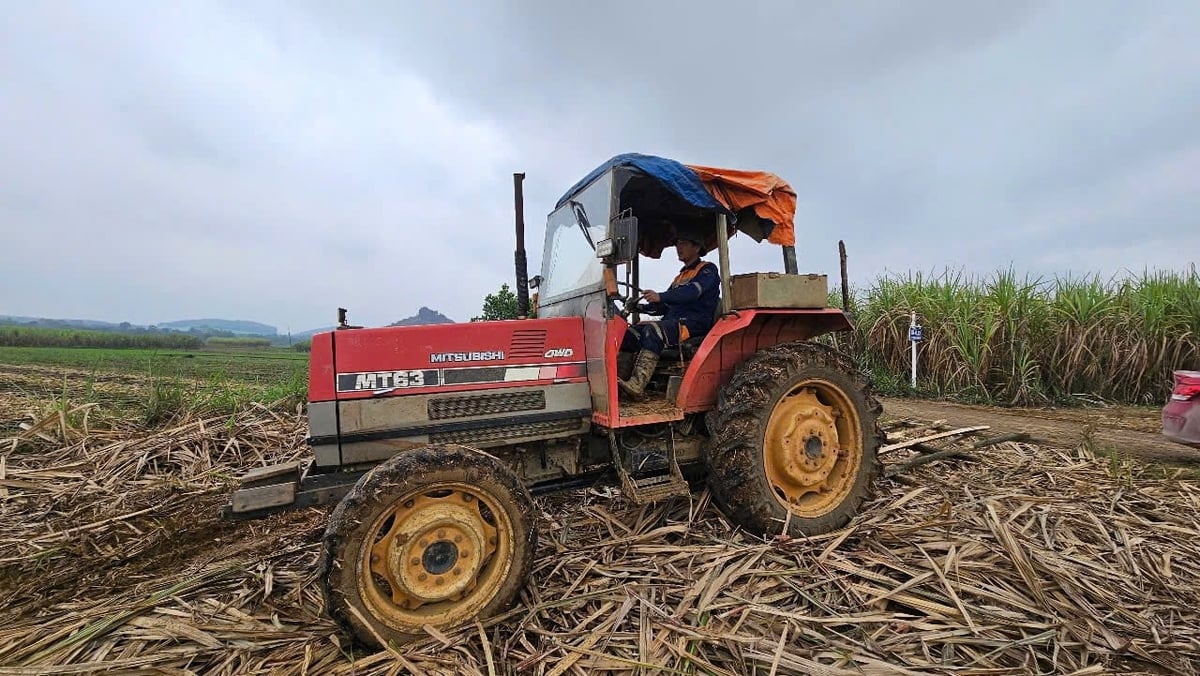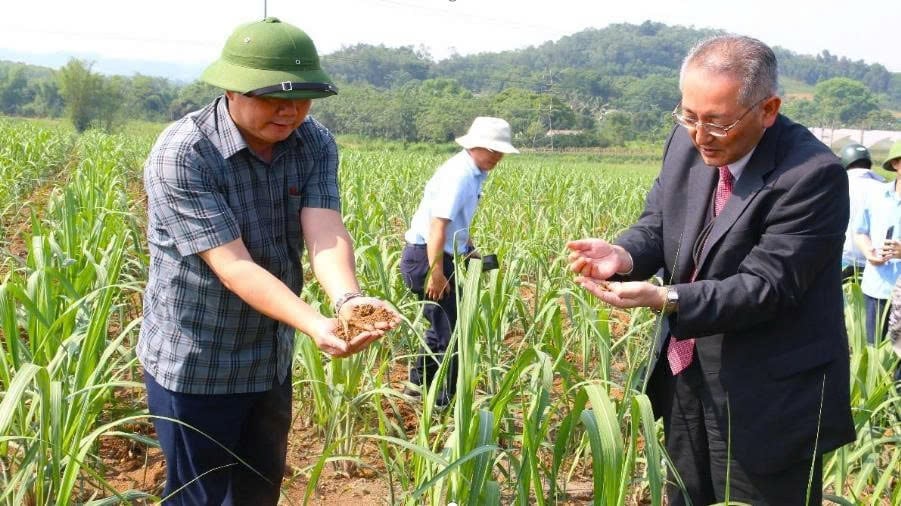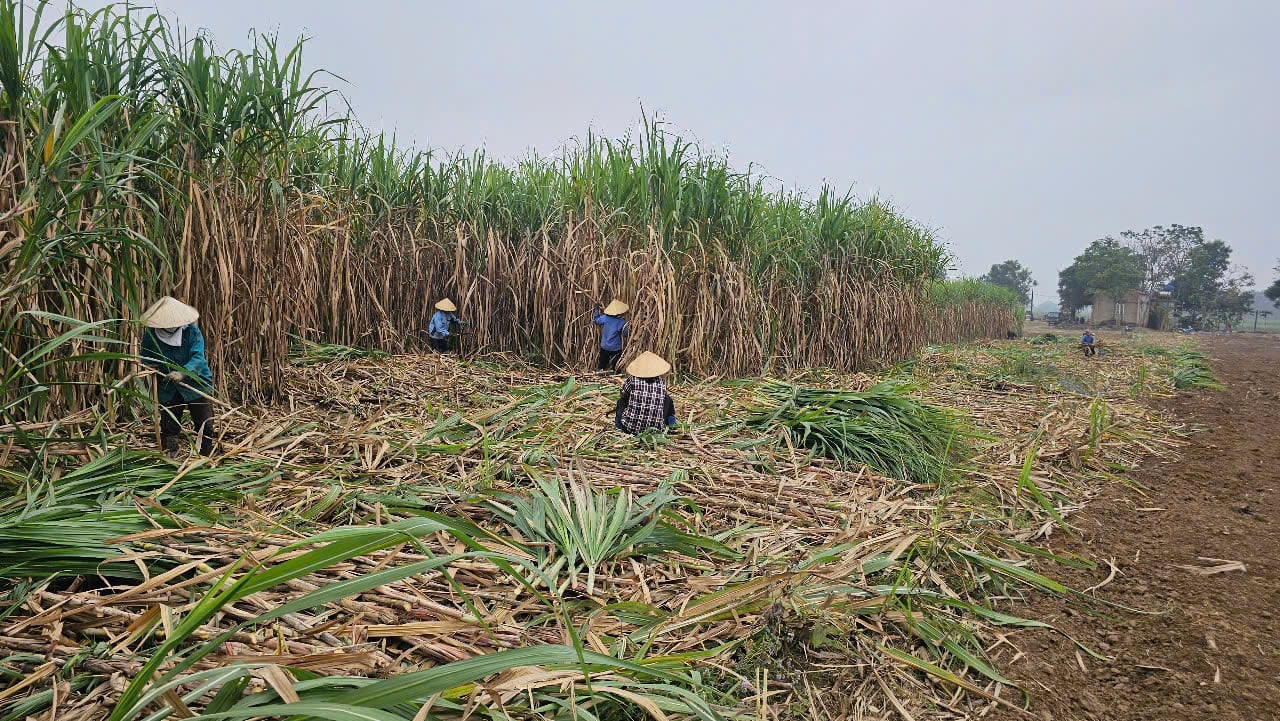December 17, 2025 | 15:58 GMT +7
December 17, 2025 | 15:58 GMT +7
Hotline: 0913.378.918
December 17, 2025 | 15:58 GMT +7
Hotline: 0913.378.918
Previously, after each sugarcane crop cycle in Tho Lap commune (Thanh Hoa province), fields would be shrouded in smoke from burning leaves. The land gradually lost fertility due to heavy chemical fertilizer use, requiring extensive soil reclamation efforts. By adopting emission-reducing sugarcane planting methods, farmers not only reduce cultivation costs but also contribute to environmental protection, opening up income opportunities through "clean gas sales."
Nguyen Dinh Dinh (66 years old, Tho Lap commune, Thanh Hoa province), who owns 5 hectares of emission-reducing sugarcane, says: "Using chemical fertilizers helped the sugarcane grow fast, but the soil became hard and required extensive reclamation efforts. Since switching to organic fertilizers as guided by technical experts, I've noticed the soil becoming softer and more fertile, the sugarcane healthier, and disease-resistant, with yields comparable to traditional methods. Planting emission-reducing sugarcane not only cleans the soil and air but also opens up opportunities to sell carbon credits, which has energized farmers," Mr. Dinh said.

After each sugarcane crop, the land often lost fertility due to heavy chemical fertilizer use, requiring extensive soil reclamation efforts. Photo: NAT.
Participating in the emission-reducing carbon planting model, farmers receive comprehensive support, from high-yield sugarcane varieties to organic fertilizers and microbial agents provided on deferred payment terms, helping to reduce initial investment pressures. Mr. Dinh's family is more advantageous than other households by utilizing organic fertilizers from their chicken farm, enriching the soil. Chicken manure composted for sugarcane fertilization not only saves costs but also improves soil quality.
Furthermore, when participating in the carbon emission reduction project, Mr. Dinh receives detailed guidance from Lam Son sugar mill technical officers on sugarcane planting, care, and the prohibition of post-harvest leaf burning. In addition, production volume and product output are assuredly stable through partnerships with factories.
To support farmers in emission-reducing sugarcane planting and promote sustainable production transformation, Lasuco not only implements a program to support input materials on deferred payment terms but also builds a comprehensive product marketing chain. From a few initial trial models, there are now hundreds of successful conversion households from traditional sugarcane planting to emission-reducing sugarcane planting in various communes of Thanh Hoa province.
A significant milestone marking Lam Son Sugar Joint Stock Company's (Lasuco) transition in enhancing the sugar cane raw material value strategy is the signing of a cooperation contract to implement the carbon emission reduction project with two Japanese partners: Idemitsu Kosan Group and Sagri Company, at the end of 2024.
According to the cooperation agreement, Idemitsu Kosan acts as the investor, coordinating the project with Vietnamese authorities; Sagri is responsible for providing technology, satellite data management, and supporting carbon credit registration; while Lasuco directly implements the project on-site, working with farmers to build environmentally friendly agricultural models.
The pilot phase will be implemented on 500 hectares from 2025, applying modern technologies such as satellite monitoring, soil and crop data analysis, and fertilizer optimization processes. The goal is to reduce greenhouse gas emissions, especially nitrous oxide (N2O), while enhancing carbon sequestration capacity in the soil.

Piloting project is expected to reduce greenhouse gas emissions, especially nitrous oxide (N2O), while enhancing carbon sequestration capacity in the soil. Photo: NAT.
By 2026, the project is expected to expand to 8,000 hectares and officially enter the commercial operation phase. Calculations indicate that Lasuco could earn up to 480,000 tons of carbon credits when expanding to 8,000 hectares, equivalent to USD 480,000 (at the lowest carbon credit price of USD 1), approximately over 12 billion Vietnamese dong.
Le Quang May, project coordinator for carbon emission reduction, states that emission-reducing sugarcane planting is a sustainable agricultural production trend. These changes not only help save input costs but also maintain stable productivity. Moreover, profits from carbon credit sales will be returned to farmers, significantly improving their economic livelihoods.
"A highlight of the new farming method is no post-harvest sugarcane leaf burning, utilizing by-products to enrich the soil, and gradually transitioning from chemical to organic fertilizers. These changes improve soil health, reduce production costs, and limit greenhouse gas emissions," Mr. May shared.

Emission-low sugarcane planting is a sustainable agricultural production trend. Photo: NAT.
As of mid-May 2025, the project has completed the Project Description Document and submitted it to the waiting list on the international Verra system. The document focuses on technical solutions such as reducing synthetic nitrogen fertilizers, using organic fertilizers, not burning plant residues, and extending sugarcane root harvesting cycles to increase carbon accumulation in the soil.
All parties have conducted on-site inspections to assess implementation conditions, data collection methods, and establish information flows from farmers to Lasuco's satellite monitoring system. The MRV (Measurement - Reporting - Verification) system is being applied to ensure transparency and reliability throughout the project operation process.
Participating in the voluntary carbon credit mechanism (VCM) enhances the sustainability and credibility of the Lam Son sugar cane value chain and opens up opportunities to access global carbon financial resources. With close coordination among relevant parties and a modern monitoring system, the project is being implemented on schedule, aiming to become a model of low-carbon agriculture in Vietnam.
Translated by Kieu Chi

Professor Nguyen Duc Ngu, the third generation of leaders since the establishment of Vietnam’s Hydrometeorology sector has witnessed and lived through the long arc of its development.

(VAN) Climate change, saline intrusion, and unsustainable farming practices are depleting agricultural land in the Mekong Delta. Restoring soil health is a key solution for the future of agriculture.

(VAN) Agroforestry coffee not only enhances coffee quality but also helps farmers in Quang Tri enter carbon credit market with high expectations.

(VAN) Towards Net Zero 2050, fertilizer manufacturers are proactively developing bio-based products, reducing emissions, and demonstrating responsibility to the environment.

(VAN) The smart rice cultivation model, which reduces methane emissions and aims at developing agricultural carbon credits, has been deployed in Thai Nguyen province and delivered positive results.

(VAN) The purpose of this visit is to unify the proposal for a technical assistance project supporting sustainable agricultural and forestry development in Angola.
![Unlocking carbon credit potential: [3] New direction for rice production](https://t.ex-cdn.com/nongnghiepmoitruong.vn/608w/files/huyenvt (e)/2025/12/10/3428-2-092319_209.jpg)
(VAN) Low-carbon rice models in Thanh Hoa are opening up opportunities for a green, circular agriculture, aiming at carbon credit generation.